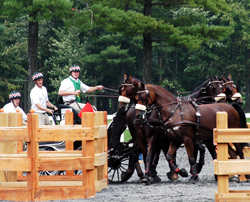
In his address to the Maclay finalists before the competition, George Morris, our USET show jumping chef d’equipe and judge of the finals, raised everyone’s sights, which he can do so well. He spoke glowingly of our American jumping style and the tradition of excellence that has been handed down through the years.
Morris made all the finalists feel they were a part of that tradition by virtue of their qualifying for the event. Obviously, hunter seat equitation is important to them, or they would not have been there. Many have ambitions to polish their skills and one day represent our country as so many finalists before them have done.
One finalist I have watched since her early childhood was Brianne Goutal, the winner. For her, the beginning was not easy and more than a little scary. Then she went to Peter Lutz who mounted her well and taught her well. She regained her confidence, went on to train with Frank Madden, and the rest is history. I wish her the best in future endeavors because she loves her horses and is dedicated to the sport.

The course was brilliant, vintage George Morris. He and Susie Humes asked all the key questions, and the contestants that could not answer them were in only a little trouble, not a lot of trouble.
The first fence on the left side of the ring was an old-fashioned, very vertical brush jump with no wings. It demanded a calm, accurate ride, then a short right turn to the second, an oxer, then past the ingate to a line across the diagonal. The third jump was a rather wide triple bar that asked for a determined ride. Then four normal to forward strides to a narrow jump and a steady three strides to the fifth.
Next was a very short turn to a very narrow vanilla rail jump and another short left turn to its twin. Then came a right turn and the long gallop to see if the riders could free up and gallop to the oxer going toward the ingate; immediately another quick turn left to jump a vertical into the wall followed by a bending six strides slightly left to an in and out of oxers, and another right bending line of five or six strides to the final Animal Planet jump.
The course rode just about as it walked so early riders were at little disadvantage if they knew their horses well. Julie Welles was a standout in the early going.

The judges were looking for an intelligent, sympathetic ride on an obedient, willing horse. Too-passive “under riders” and too-aggressive “over riders” would not do well. Accuracy was key but a mechanical rider was out of luck at places like the long gallop to the oxer at the ingate.
Even in the early going there were quite a few creditable rounds, so I went away from Syracuse thinking that hunter seat equitation was still a very sound basis for our much-admired American jumping style. It will be interested to see how many of these youngsters will go on to be Olympians and World Class riders. There are several who could do it all if they want to.
Working from her longtime base of Coker Farm, in Bedford, N.Y., Judy Richter has been the trainer of many nationally ranked hunter/jumper and equitation riders.
Check out competitor Natalie Johnson’s behind-the-scenes Maclay report in her Inside the Maclay Finals Blog.





